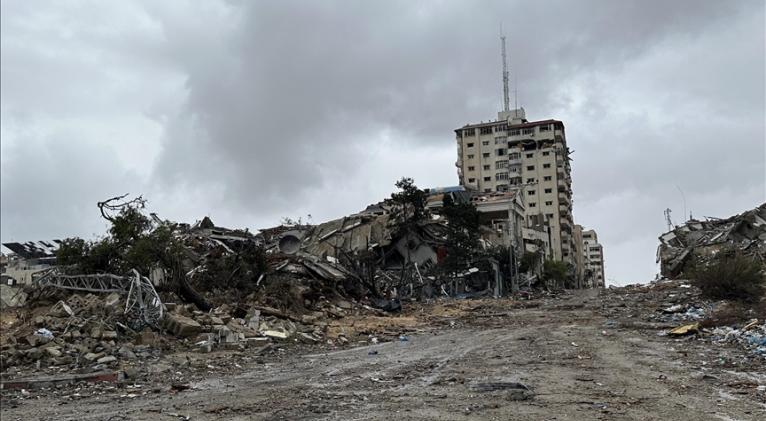What's Left Of Gaza: Scenes Of Destruction, Pangs Of Desperation
especiales

When we ask Sister Nabila Saleh to describe the situation in Gaza, she responds by sending ten photos: images of rubble, destruction, and desolation. They suggest that the point of no return has long been surpassed.
Sister Nabila is of Egyptian origin and spends her days in the parish of the Holy Family in Gaza City, where all of the remaining Christian community is sheltering.
For the latest news & views from every corner of the world, Worldcrunch Today is the only truly international newsletter. Sign up here.
Communication is challenging; on WhatsApp, conversations are impossible, only snippets of written sentences arrive on each side. Still, they suffice in describing the hellish conditions they've been facing for the past seven weeks.
"The situation is very difficult, everything is destroyed, nothing is left," she said. "Living is a challenge, for now, no aid is reaching us, there is only one supermarket with some basic supplies."
Unbearable conditions
The scenes found in Sister Nabila Saleh's photos are the same as seen from the hill of Sderot in Israeli territory, located 1.3 kilometers from the border of Gaza. Destruction as far as the eye can see, bordered by the waves of the Mediterranean Sea.
"We are witnessing an unbearable human tragedy. Despite the pausing of hostilities, humanitarian needs persist," an official of the International Committee of the Red Cross explains to La Stampa. "People lack basic necessities, the bare minimum for survival. The aid distributed is not sufficient to meet the needs of hundreds of thousands of people in desperate need of assistance."
The official notes that colder weather is coming, with masses of people are living in tents without beds, pillows, or blankets. "Many have no homes; they have been separated from family members. Our surgical teams report inflows of people - organized or spontaneous - in need of urgent medical care, but there are neither supplies nor staff to respond to these emergencies," he said. "Food and water are very scarce; people are only thinking about survival, with no capacity to look to the future."
Death and displaced
According to the Hamas-run health ministry, more than 14,800 Palestinians, mostly women and children, have been killed during the Israeli offensive in Gaza. On the other side, there were 1,200 victims of the terrorist attacks on October 7th in southern Israel.
Gaza has not had a regular supply of electricity since its only power plant was shut down on October 11.
The only flicker of hope has been the somewhat shaky ceasefire between Israel and Hamas since Friday that has allowed a wave of aid to reach the Strip, with 200 trucks coming in each day, although humanitarian organizations consider the convoys far from sufficient for meeting the needs of the two million people still in Gaza.
The resources include deliveries of fuel to power generators in facilities, including hospitals. Gaza has not had a regular supply of electricity since its only power plant was shut down on October 11. As a result, residents burn doors, furniture, and piles of garbage in order to cook. They sleep crowded in school classrooms and strangers' houses, and raid trucks bringing aid from Egypt in a desperate search for supplies.
The ceasefire has at least allowed the possibility of burying the dead. Meanwhile, 1.7 million people are displaced, most crowded in the southern portion of Gaza, which has effectively been cut in half by the Israeli offensive.

People wait at a fuel filling station in Khan Younis located in Southern Gaza
Point of no return
Though misery and grief is widespread throughout Gaza, the situation in the North, including Gaza City, is particularly desperate.
"Members of our team visited the northern area a few days ago and report that the level of destruction is indescribable. There are people still living there, but we don't know how they manage to do so: they are holed up inside and around the rubble and destroyed buildings," the Red Cross official adds. "The South now hosts hundreds of thousands of people in an area unprepared for this. People sleep wherever they can."
According to the United Nations, tens of thousands, if not hundreds of thousands, are estimated to have stayed in the North, many to be close to sick, injured, or elderly relatives who could not move. Others are afraid they won't be able to return to their homes.
The needs are endless
According to the Red Cross, Israeli forces prevented tanker trucks loaded with fuel from entering through the northern crossing yesterday. While in the South, food and other necessities are more readily available, an increasing number of Palestinians claim they cannot afford the soaring prices of flour, vegetables, and drinking water for which they sometimes wait in line overnight.
"We have reiterated the need to ensure a continuous supply of aid. The challenges people must face are overwhelming, physically, psychologically, emotionally; needs continue to increase," said the Red Cross. "Essentials like toothbrushes and baby diapers are needed, along with more specific items like weapon wound kits and surgical tools. And again, food and water, chlorine tablets for water purification, disposable items like gloves, bandages, and saline solution, body bags, heavy machinery to dig through the rubble. The needs are endless and encompass every aspect of life."
As for plans for the future? That's a luxury that the inhabitants of Gaza can simply not afford to think about.













Add new comment